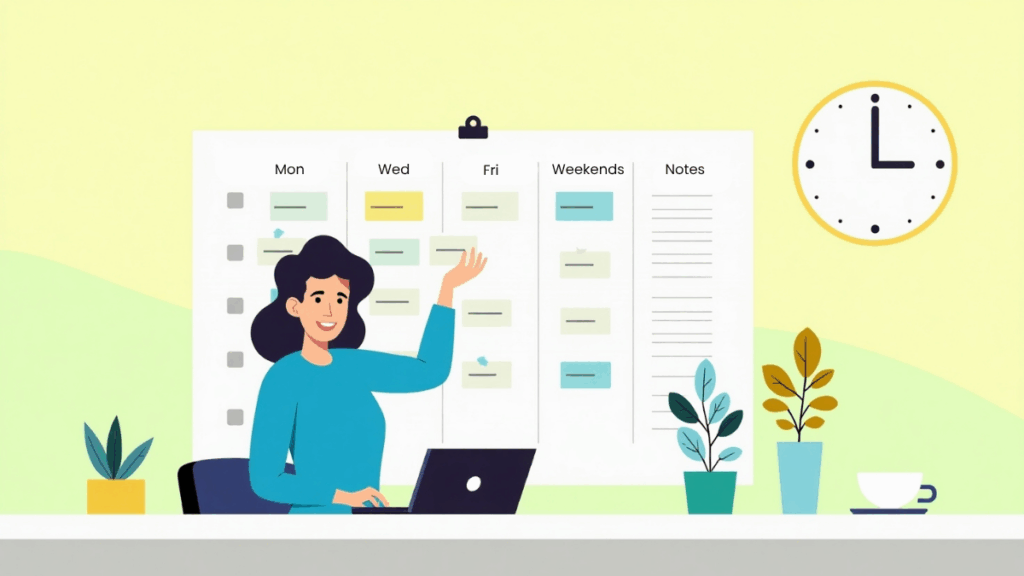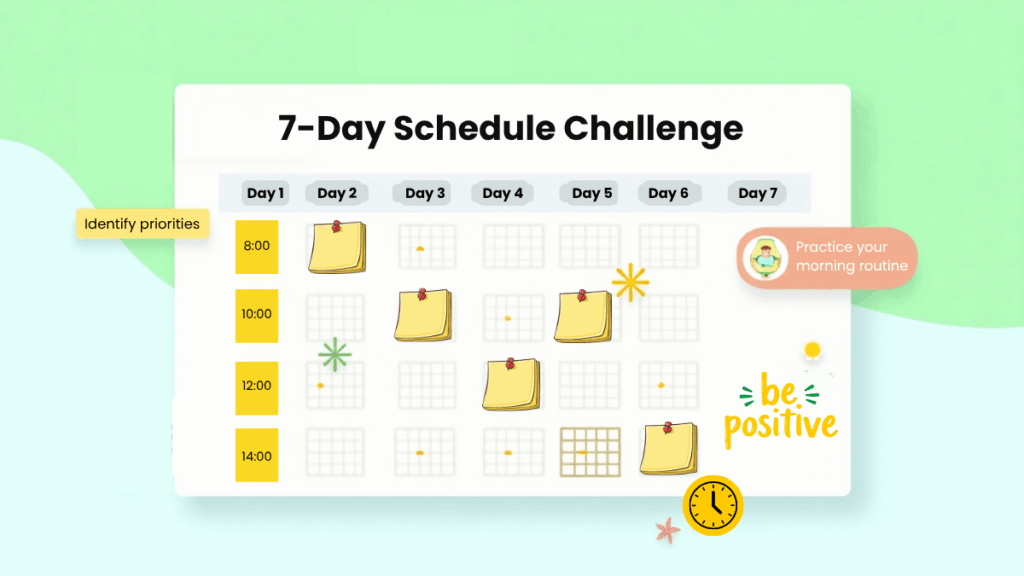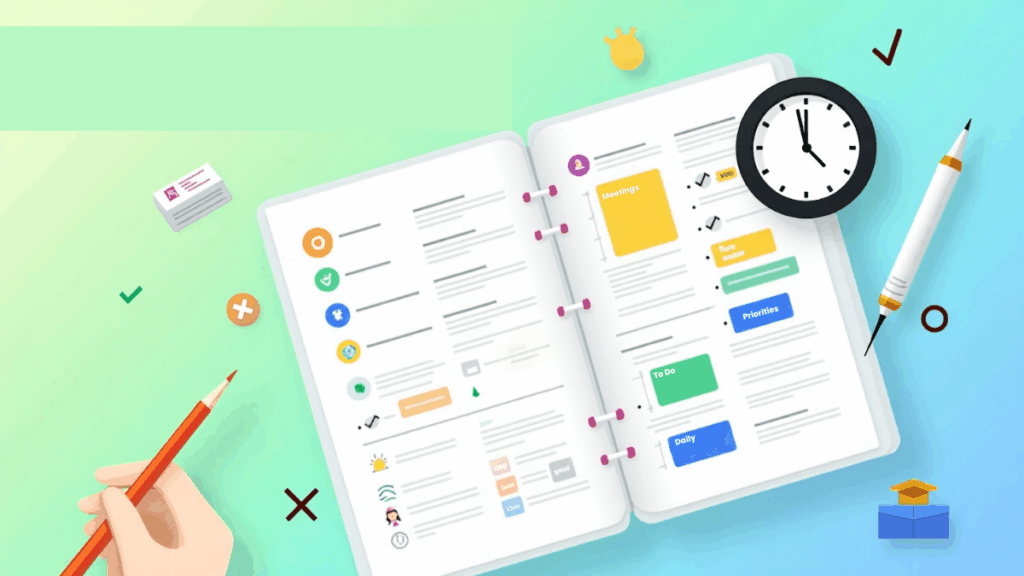Learn How to Create a Realistic Schedule that Fits Your Life
Explore practical time management strategies and discover tools that make daily organization effortless.
Create a realistic schedule by auditing your time, setting priorities, and editing appointments using a flexible planner. Add buffer time, avoid common mistakes, and regularly adjust to stay on track.
What Is a Schedule Maker?
A schedule maker is more than a calendar. It’s a system that aligns your daily activities with your goals. Whether you prefer paper or digital, a good schedule maker helps you:
- Focus on high-impact work
- Prevent scheduling conflicts
- Balance deep focus with rest
Tip: Use a planner to block specific tasks, assign time slots, and adapt quickly to changes. Include detailed event descriptions and additional details to stay clear and consistent.
Why Scheduling Works
A schedule does more than organize your time and projects —it shapes your behavior. It helps you:
- Stay focused by reducing distractions
- Work smarter by matching tasks to energy levels
- Maintain boundaries between work and life
- Reduce decision fatigue with clear routines
💡 Mobile-friendly visual planners help prioritize tasks, reduce burnout, and boost personal and team productivity—especially useful for remote teams. Thus, they enhance both individual and team productivity.
Why Use Schedule Templates?
Schedule templates give you a head start without starting from scratch and allow you to print them easily. Use them to:
- Quickly plan your day or week
- Adjust recurring tasks efficiently
- Save time and reduce mental load

Popular templates exist for:
- Remote workers
- Freelancers
- Parents
- Teams
How to Build a Schedule in 5 Steps
Before you begin, ask yourself:
- Do you often feel rushed?
- Are your goals slipping through the cracks?
- Are your work and personal life bleeding into each other?
If yes, start here:
1. Audit Your Time
Track your time for 2–3 days. You’ll see:
- Where your time goes
- Which tasks matter most
- When you’re most productive
2. Set Priorities
Use the Eisenhower Matrix to categorize tasks and projects according to your specific needs :
- Urgent & important
- Important but not urgent
- Low priority
- Delegable
This helps you focus on work that moves you forward, not just work that fills time.
3. Choose a Scheduling Method
Try methods like:
- Time blocking – batch similar tasks
- Themed days – assign a theme per day
- Task batching – minimize context switching
4. Schedule Fixed Commitments
Add your non-negotiables—meetings, deadlines, school runs—to your calendar.
5. Add Flex Time
Leave space between:
- Work blocks
- Meetings
- Tasks
Start Your Day with Intention
Use a simple morning routine to set the tone:
- Journal or reflect
- Move your body
- Review your plan for the day
Build Supportive Habits
A solid schedule supports—not replaces—healthy routines. Build in:
- Movement and breaks
- Meals
- Sleep
How to Stick to Your Schedule
The most effective schedules don’t just sit there—they live with you. To maintain yours:
- Review it each night
- Align tasks to your energy levels
- Preview your calendar each morning
- Share it with others for accountability
How to Overcome Scheduling Challenges
Life isn’t static—your schedule shouldn’t be either. Stay adaptive by:
- Prioritizing just 2–3 big things a day
- Letting go of guilt when plans shift
- Focusing on outcomes over output
- Building for progress, not perfection

Staying flexible allows you to adjust priorities without losing momentum or clarity.
Scheduling Mistakes to Avoid
Avoid these common pitfalls:
- Packing your day too tightly
- Skipping breaks
- Ignoring recurring tasks
- Relying on scattered tools
- Building a system too complex to maintain
Sample Schedules
Tailor your routine to your lifestyle:
Remote Worker
- 9:00 AM – Deep work
- 11:30 AM – Email
- 12:30 PM – Lunch
- 1:00 PM – Meetings
- 3:00 PM – Creative tasks
- 5:00 PM – Wrap-up
Freelancer
- 8:00 AM – Proposals
- 10:00 AM – Client calls
- 12:00 PM – Admin
- 2:00 PM – Creative work
- 4:00 PM – Planning
Busy Parent
- 6:30 AM – Morning routine
- 8:00 AM – School drop-off
- 9:00 AM – Work
- 3:00 PM – Errands
- 6:00 PM – Family time
- 8:30 PM – Plan tomorrow
Small Business Owner
- 7:30 AM – Review orders, finances, and team updates
- 9:00 AM – Deep work (strategy, marketing, or development)
- 11:30 AM – Team check-ins or vendor calls
- 1:00 PM – Lunch break and admin catch-up
- 2:00 PM – Client work or product/service delivery
- 4:00 PM – Social media, outreach, or inventory
- 5:30 PM – Daily wrap-up and plan for tomorrow
Each example integrates personal and professional priorities into the process in a practical, repeatable format.
Goal Alignment
Think beyond your to-do list: What long-term goals are you aiming for?
- Write down your goals
- Break them into tasks
- Distribute those tasks across your week

Break big goals into trackable weekly actions and see your progress unfold, guiding you through making a schedule.
Review and Adjust Regularly
Each day, ask:
- What did I complete?
- What went off track?
- What can I adjust tomorrow?
Making time for this quick check-in helps you learn how to make a schedule and stay intentional and responsive, not reactive. Minor daily tweaks lead to significant, long-term wins.
Weekly Schedule Overview
Monday–Friday: Work Schedule
- 9:00 AM – Deep focus work (creative, strategic, or high-priority tasks)
- 11:30 AM – Meetings and communication (email, calls, status updates)
- 1:00 PM – Lunch break and a short walk
- 2:00 PM – Client projects or collaborative work
- 4:00 PM – Admin, prep for the next day, and daily review
Weekends: Priorities
- Reconnection – Spend quality time with family and friends
- Reset – Run errands, organize your space, catch up on sleep
- Reflection – Look back at what worked during the week
- Planning – Preview next week and update your calendar
Use weekends to zoom out, not fill up. A light plan can go a long way without overloading your rest.
7-Day Schedule Challenge
Trying to build better habits? This simple 7-day challenge can help you with a full list of tasks :
Day 1: Track your time
Log how you spend your hours to reveal time drains and establish a clear baseline for improvement.
Day 2: Identify priorities
Sort tasks using the Eisenhower Matrix—urgent, important, and so on.
Day 3: Choose your method
Try time blocking, task batching, or themed days. Choose one that matches your energy and work type.
Day 4: Add your fixed commitments
Plug in your appointments, meetings, shift changes, and non-negotiables. These form the structure around which your flexible tasks will orbit.
Day 5: Add buffers
Leave breathing room. With custom settings, Use buffers to prevent burnout, catch up if things run long, and mentally reset.
Day 6: Practice your morning routine
Review your schedule in the morning to mentally prepare for what’s ahead. Keep your planner or calendar accessible—digital or physical—to stay aligned throughout the day.
Day 7: Reflect and reset
What worked? What didn’t? Use these insights to adjust your schedule—keeping it practical, flexible, and aligned with your real life.

Tip: Keep it real, not perfect.
Your schedule should evolve with your week.
- Be flexible
- Adjust as needed
- Aim for progress, not perfection.
Best Tools for Scheduling
Calendars
These tools can store and display your events, making them the backbone of your scheduling system.
- Google Calendar – Widely used digital calendar with smart integration across Google Workspace and third-party tools.
- Apple Calendar – Native calendar for Apple devices, ideal for syncing across macOS and iOS.
- Microsoft Calendar – Part of Outlook; used by businesses to manage meetings and shared calendars.
Online Appointment Schedulers
These platforms help you manage appointments, sync availability, and automate bookings.
- Calfrenzy – A powerful and affordable scheduler designed for individuals and teams. Offers branded booking pages, group coordination, calendar sync, time zone detection, and integrated payments.
Pricing: Free forever plan is available. Premium features are available for $1.25/month (per organizer). Check out Calfrenzy’s pricing page to find the plan that fits your needs. - Calendly – A popular tool for setting one-on-one or team meetings with automatic calendar syncing and buffer time options.
Pricing: Free basic plan. Paid plans start at $10/month (per user). - Acuity Scheduling – Feature-rich appointment scheduler tailored for service-based businesses with payment collection and intake forms.
Pricing: No free plan. Paid plans start at $16/month.
Time Trackers
Track your time on tasks and projects to improve productivity and billing.
- Toggl – Lightweight time tracker with one-click timers and detailed reports; great for freelancers and teams.
- Clockify – A free time tracking tool with project-level insights, ideal for businesses managing hourly work.
Task and Project Organizers
- Todoist – A flexible task management app with natural language input and cross-platform syncing.
- Notion – A highly customizable workspace for notes, databases, calendars, and task management.
- Trello – Visual project management tool using drag-and-drop cards and boards for a team or solo workflows.
Frequently Asked Questions
What if my day is unpredictable?
Use flexible time blocks instead of rigid hour-by-hour schedules. Focus on priorities and allocate buffer time between tasks.
How do I stay consistent with scheduling?
Build the habit gradually. Start with a weekly plan and a short daily review. Use simple tools that make it easy to visualize and adjust your schedule.
What if I work in multiple time zones?
Use a digital planner with an integrated time zone planner to block tasks in your local time while staying aligned with teammates or clients across different regions. This helps you visualize overlapping availability, schedule meetings without conflict, and avoid the hassle of converting time zones manually. A good time zone planner ensures your workflow stays organized, no matter where your team is located.
Is it okay to miss scheduled tasks?
Absolutely. The goal is consistency, not perfection. Reschedule anything you miss, and adjust your plan based on what you learn.
Can scheduling work for creative tasks?
Yes. Block time for creative work when your energy is highest, and avoid multitasking. Leave room for flow without micromanaging it.
Final Thoughts
Time is your most valuable resource. A solid, flexible schedule helps you manage your work hours :
- Stay focused.
- Make consistent progress.
- Protect time for rest and recharge.
Start small. Stay flexible. Stick with it.
Sign Up Is Easy 90 Seconds
Ready to make scheduling stress free?
You can register, connect your calendar, and start scheduling in just 90 seconds.
It’s that simple.






